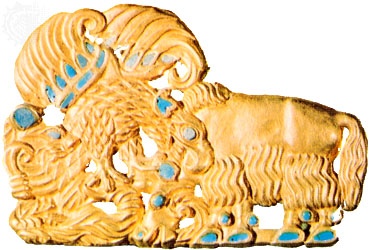buckle
clothing
 clasp or catch, particularly for fastening the ends of a belt; or a clasplike ornament, especially for shoes (shoe). The belt buckle was often used by the people of ancient Greece (ancient Greek civilization) and ancient Rome as well as by those in northern Europe, and it became the object of special care on the part of metalsmiths, who ornamented many buckles with rich and intricate designs.
clasp or catch, particularly for fastening the ends of a belt; or a clasplike ornament, especially for shoes (shoe). The belt buckle was often used by the people of ancient Greece (ancient Greek civilization) and ancient Rome as well as by those in northern Europe, and it became the object of special care on the part of metalsmiths, who ornamented many buckles with rich and intricate designs.Animal motifs were characteristic of Scythian (Scythian art) and Sarmatian decorative arts, and their belts and buckles often represented animals entwined in mortal combat. Many Germanic peoples imported these motifs, and the belt buckles almost invariably present in the graves of the Franks and Burgundians are often further ornamented with bosses of silver or bronze, chased or inlaid. A fine example of a buckle of a heavy rectangular type decorated with filigree was found in the tomb of Childeric I, king of the Franks, who died in AD 481/482. Several 7th-century gold buckles with interlacing curvilinear patterns and cutaway tongues, now in the British Museum, London, were found in the Sutton Hoo ship burial. Throughout the Middle Ages, the buckle was used especially for ornamentation; but, during the second half of the 14th century, the knightly belt and buckle took on its most splendid form, and, after the early 15th century, the belt and buckle never again regained such importance.
The shoe buckle has also been important as an ornament. Jewelled buckles (with real or imitation gems) were worn during the reign of Louis XIV, and at about the same time the shoe buckle became popular in the United States. In 18th-century Europe, buckles became even more decorative. Fashionable fops of the 1770s reacted against simple styles and wore thin shoes with large buckles made of gold, silver, and other precious metals and set with imitation or real gems. In the 20th century jewelled or ornamented buckles were popular in women's fashions, though precious gems were rarely used.
- pursuit racing
- Puruhá
- Purulia
- purusha
- Purus River
- Purvachal
- purveyance
- Purviance, Edna
- Puryear, Martin
- Purí and Coroado
- pus
- Pusa
- Pusan
- Pusey, E B
- Pusey, Nathan
- pusher lace
- Pushkar
- Pushkin
- Pushkin, Aleksandr Sergeyevich
- Pushkin Fine Arts Museum
- Pushmataha
- Pu Songling
- pussy-toes
- pussy willow
- Pusur River